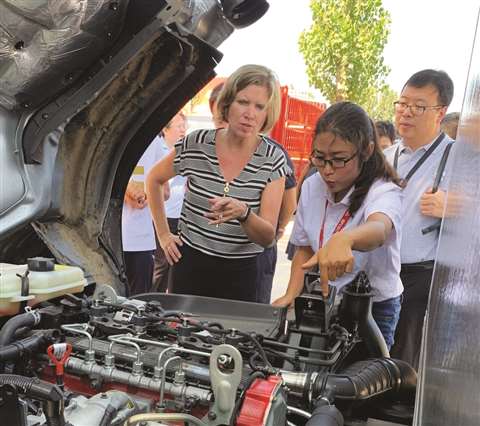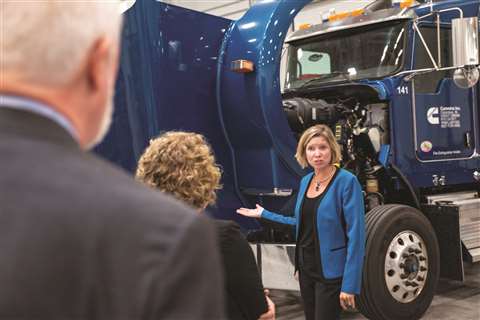Cummins’ homegrown CEO talks about path to the top, challenges ahead
30 September 2022
If you wrote a movie script about Jennifer Rumsey’s career path to becoming the chief executive officer of Cummins Inc., it’s likely Hollywood would reject it as too improbable.
A native of Columbus, Ind., the birthplace of Cummins in 1919, she grew up babysitting the children of Cummins executives and, like nearly everyone else in the central Indiana town, was steeped in the history and culture of the company.
 A native of Columbus, Ind., and an engineer at heart, Jennifer Rumsey recently took over as the seventh CEO in the history of Cummins. (Photo: Cummins)
A native of Columbus, Ind., and an engineer at heart, Jennifer Rumsey recently took over as the seventh CEO in the history of Cummins. (Photo: Cummins)
After getting a bachelor’s degree in engineering from Purdue University and then a master’s degree in engineering from MIT, she spent a little over a year at Nuvera Fuel Cells before joining Cummins in 2000.
From there her progress has been continuous to the point where she was named the company’s seventh CEO, succeeding Tom Linebarger, as of Aug. 1.
Diesel Progress met with Rumsey in Columbus shortly before she assumed her new position, as she discussed her path to the top and the challenges ahead for the company.
On becoming CEO of Cummins:
It really has been for me a journey that started with a combination of my mother – who was very strong and determined and kind of set me on a course to believing I could be anything I wanted to be – and then (former Cummins chief technology officer) John Wall, who spotted me early and encouraged me to pursue engineering.
I have always wanted to use my engineering background and then engineering and leadership’s skills to do something meaningful in the world and that has led me to this place. And I realized that given the transition our industry is going through and the opportunity in our business, that I was the right one to be CEO for Cummins. We have a tremendous opportunity, I think, and so that’s really what’s drawn me to this point. And it’s been only in recent years that I recognized that that was my dream.
On how her background in engineering is a benefit in her new position:
I do think of myself as an engineer. It pains me when I re-enter the country and I fill out that form where you put in your occupation to not write “engineer.” I write general management now.
With the changes happening in our industry, I think that [I have a] deeper understanding of our customers, how they use our product and the technical solutions, and how those fit together. And for me, it’s always been, even in engineering roles, about this intersection of the technical solution, what the customer needs and how do you make the business successful.
That’s exactly the challenge that we face right now. We need to decarbonize our industry. Our industry’s a critical part of the economy, so we need to do it in a way that makes sense for our customers’ business. Knowing the technology piece and really what works, what doesn’t work and what questions to ask, I think is a benefit to me.
When the transition away from combustion engines will occur:
It’s a great question and it’s a tough question to answer. When we talk about Destination Zero and decarbonization, we talk about “start today,” which is with our engine-based solutions, reducing CO2, whether it’s diesel or other fuel, and accelerating the solutions that get to zero.
The answer to the question on “how long will it take?” depends somewhat on regulation and incentives that will help drive adoption of these new technologies and infrastructure to support them. It’s the classic chicken-and-egg problem – do I invest in bringing this new technology to market if it’s going to cost more, if I don’t know if there’s going to be an infrastructure? So, we need to start on the applications where it makes sense, use that to start to build out infrastructure and bring costs down and then it will build over time.
 “We need to decarbonize our industry. Our industry’s a critical part of the economy, so we need to do it in a way that makes sense for our customers’ business.” - Jennifer Rumsey, CEO, Cummins
“We need to decarbonize our industry. Our industry’s a critical part of the economy, so we need to do it in a way that makes sense for our customers’ business.” - Jennifer Rumsey, CEO, Cummins
At our analyst day, we showed some scenarios on adoption that say that medium-duty (vehicles) will move first and it’s somewhere in the range of 22% to 30% by 2030. We expect our engine-based business – given the investment we’re making in market-leading products and the scale position we have, the partnerships we have globally – will continue to grow certainly through this decade. It’s just hard to call 2030 to 2040 and how that is going to play out.
On the potential of combustion engines using different fuels:
Low-carbon or zero-carbon fuel solutions and engines can definitely be an important part of the transition and even the final answer for certain applications. We expect Europe will recognize hydrogen internal combustion engines as zero [emissions]. That’s another area of education and advocacy for us in the U.S. and we are investing in hydrogen engines, which you can see in our lobby.
There are also some other drop-in, liquid-based, zero-carbon fuels, maybe not scalable as a broad solution, but we also continue to pay attention to the role that those might play.
On when electric and hydrogen infrastructures will emerge:
On the electrical infrastructure, the applications where it makes the most sense today have a more limited-range, return to base operation. I think we have an opportunity to start to build out the infrastructure in pieces and then bring it together. It is not an insignificant investment or amount of work though, which we should not underestimate. That’s why I do think government incentives and engagement is needed to get it done. How do we make sure that that infrastructure itself is decarbonized, the grid is stable, we can meet the energy demands? Those are important questions, so it will take time.
On the hydrogen side, we see some good growth opportunities in our New Power business with electrolyzers and green hydrogen in places that use hydrogen already that want to decarbonize. Then also you see some of these big companies like Chevron or Shell that are thinking about: what’s our role in decarbonizing, how do we build out infrastructure? And then you’ve got big fleets.
These partnerships are critical because any one of us by ourselves I think will struggle to make it work. But by creating some of these strong partnerships, where together Walmart, Chevron and Cummins are investing in renewable natural gas engines and putting infrastructure in, then others can come long and join over time.
It’s not so clear how long it will take because of the amount of work and investment required to make that infrastructure a reality.
On what keeps her up at night:
Microprocessor and electronic component shortages continue to be a challenge and then, of course, we’re paying attention to what’s going on with the economy right now, as well. So far, supply is the bigger challenge and we’ll continue to try to build everything that we can.
It’s been a crazy and challenging little over two years now. I think the Cummins team has stepped up and performed remarkably well in the circumstances. It’s not been easy and we continue to work with our suppliers and customers to try to stabilize and address issues that exist.
It seems to be getting a little bit better as we come into the second half of this year. It’s the electronics that really continue to worry me because of the investment. So really, what we’re focused on is making sure we are where we need to be with different electronic components that are more available. The automotive industry uses certain chips that are not the most cutting-edge chips. We can’t necessarily use the most cutting-edge chips, but we use the ones that are being made in sufficient quantity. We’ve been doing some reengineering of our modules to try to address that. Those processes can take a couple of years.
But again, as we get into second half of this year, and next year, some combination of capacity, investment and electronics and us having more options, I’m cautiously optimistic we’ll improve that.






